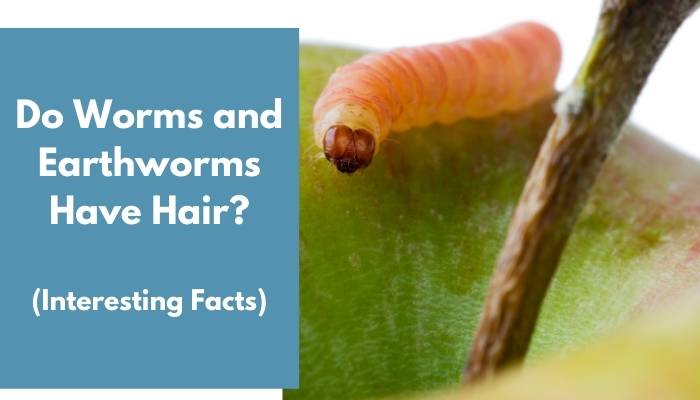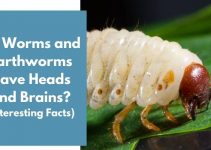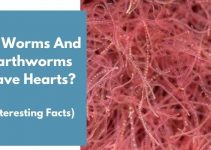Worms may not be one of the attractive animals you may see. However, they can surprise you with astonishing facts and information about them. Since worms have different lifestyles among animals, they beg comparison in some ways. For instance, you may ask:
Do worms and earthworms have hair? While worms seem bare and hairless, they do have some. Earthworms have tiny, hard-to-see bristles called Setae. You may need a magnifying tool to notice, but you can feel them through gentle strokes. While hair usually offers protection, the Setae provide help in the worm’s movement.
Since worms have a different lifestyle, some of their body parts work differently as well. In this article, we’ll answer some of the questions you may ask about worms and their hair. This way, you can better understand how it works.
Without further ado, let’s get into it!
Contents
Do worms and earthworms have some kind of hair?
As I said earlier, worms and earthworms do have some kind of hair, and it’s what we call Setae.
Worms have Setae in every segment of their body, except the first and last. Each part has four pairs of tiny, stiff hair-like projections.
Unlike ordinary hair that we see in our bodies and other animals, the Setae in worms work differently.
For instance, our hair works as a protection, and the same goes for other animals. However, for worms, the Setae work more as a tool to help them move.
If a worm encounters a part of the soil where it can’t crawl, it will release its Setae hidden in its body.
The Setae work by gripping the soil so the back part can’t move. The worm will then squeeze its circular muscles, which makes its body get longer.
Related Articles About Worms Anatomy:
- Do Worms and Earthworms Have Heads and Brains?
- Do Worms and Earthworms Have Eyes?
- Do Worms and Earthworms Have Mouths?
- Do Worms and Earthworms Have Bones?
What types of worms have hair?
Almost all kinds of worms have hair, but the usual ones are the earthworms since they are the ones we usually see.
Some other worms have hair, such as the horsehair worms, as they resemble long thin strands of hair.
Such worms have largely featureless bodies because they’re a single gonad. Moreover, they are breeders, which means their only function is to breed.
In general, almost all worms have Setae, and it has the same purpose as that of earthworms.
The Setae don’t offer protection like our hair does for us. However, they do help worms by gripping the soil and allowing them to move.
Are worms’ hairs similar to ours?
The short answer is no. The worms’ hairs aren’t similar to ours, nor other animals’ hairs.
Our hair’s purpose is mainly to protect us. The same goes for that of other animals.
In the case of other animals, the hair is more of a fur or coating. Such a part helps them protect themselves from harsh sunlight and keep them warm in extreme weather.
On the other hand, worms only have a few strands of hair in each segment. Thus, it can’t offer protection like an animal’s hair coating.
Rather than protection, the Setae offer movement for worms. The Setae help worms move by gripping the soil and allowing them to move forward.
It can be quite handy, especially if the worm finds the path slippery to crawl its way out of it simply.
What are the hairs on earthworms and worms called?
The hairs on earthworms and worms are called Setae. Further, these hair-like parts are present in each segment of the worm except the first and last ones.
Since it’s only four pairs per segment, it does not cover their body. Thus, it won’t protect worms as a usual animal hair would do.
Rather than movement, the Setae promotes more comfortable action on worms. If the worm gets stuck or can’t move in a specific part of the ground, it’ll release the Setae from its segments.
The Setae would grip the soil as the other segments move forward. Thus, it helps worms navigate, especially on very damp and slippery ground.
While the Setae may not protect earthworms from the heat or cold, they help in moving. The thing that protects worms from extreme cold and heat is their light and dark receptors.
These receptors prevent worms from staying on the surface where they can get the sun’s extreme heat to dry them out.
On the other hand, it also keeps them from getting too deep, colder, and freeze.
Read also other articles about worms’ hearts, blood, lungs, ears and legs.
Summary
In general, worms and earthworms have hair, but such hair doesn’t offer the same function. Our hair, as well as other animals’, offer protection. In the case of worms, their hair promotes movement.
The hair in worms is what we call Setae, and it’s four pairs in each segment of the worm’s body, except the first and last. The primary purpose of the Setae is to ease movement by gripping on the soil as the worm moves forward.
While the hair doesn’t offer protection, other parts of the worms do. For this reason, worms don’t lack protection to survive.
Resources
Image credits – Canva



